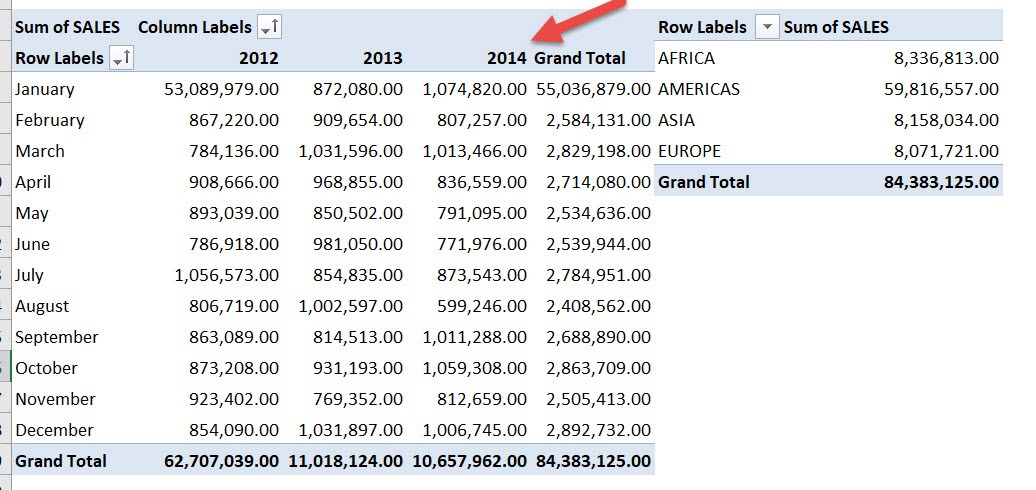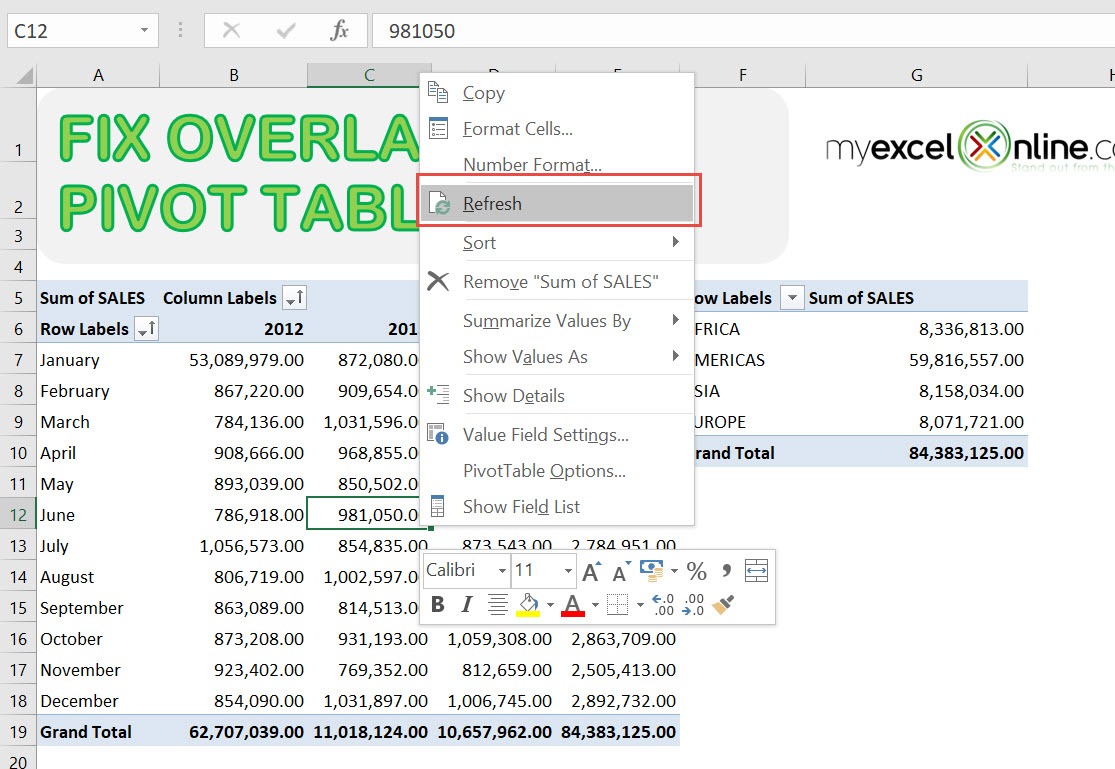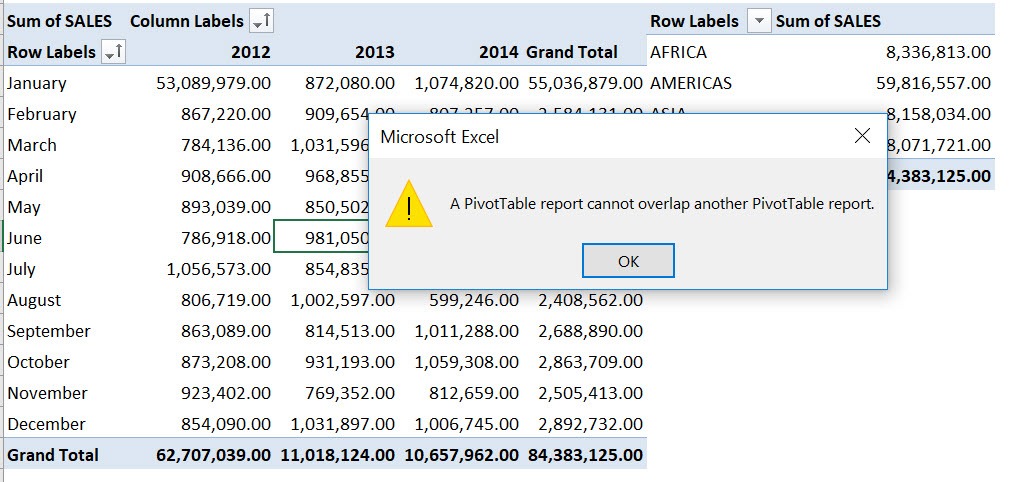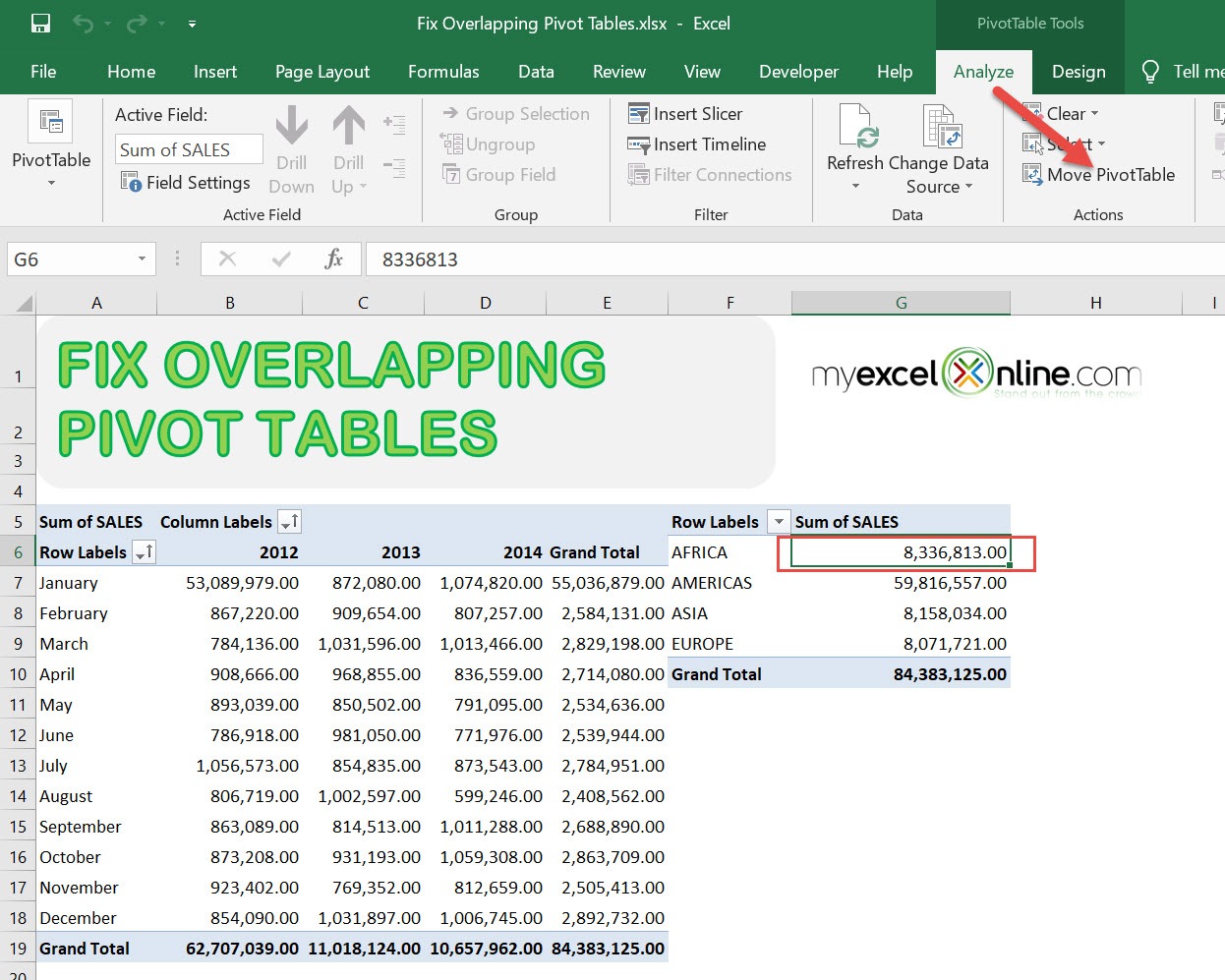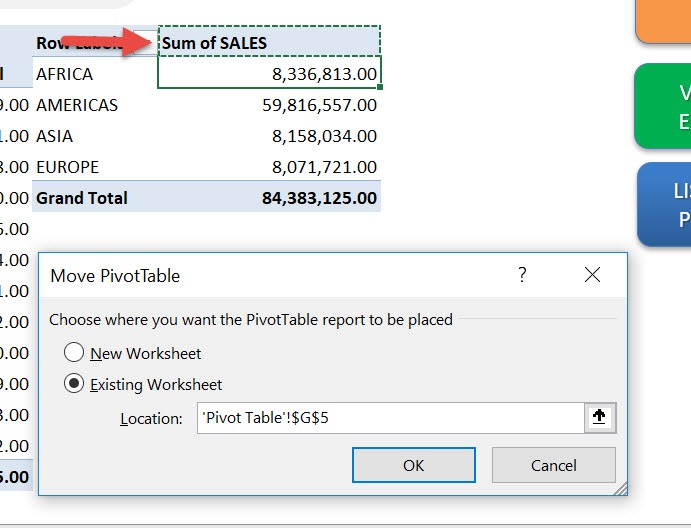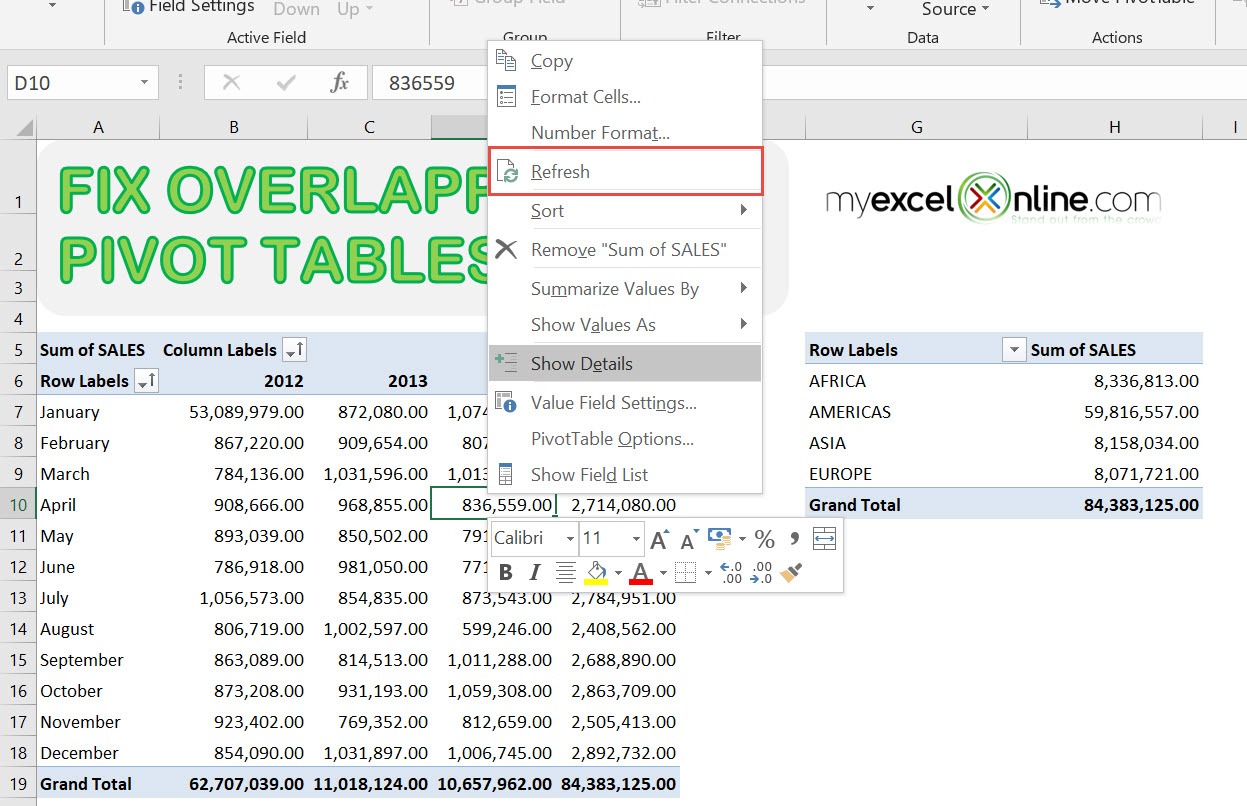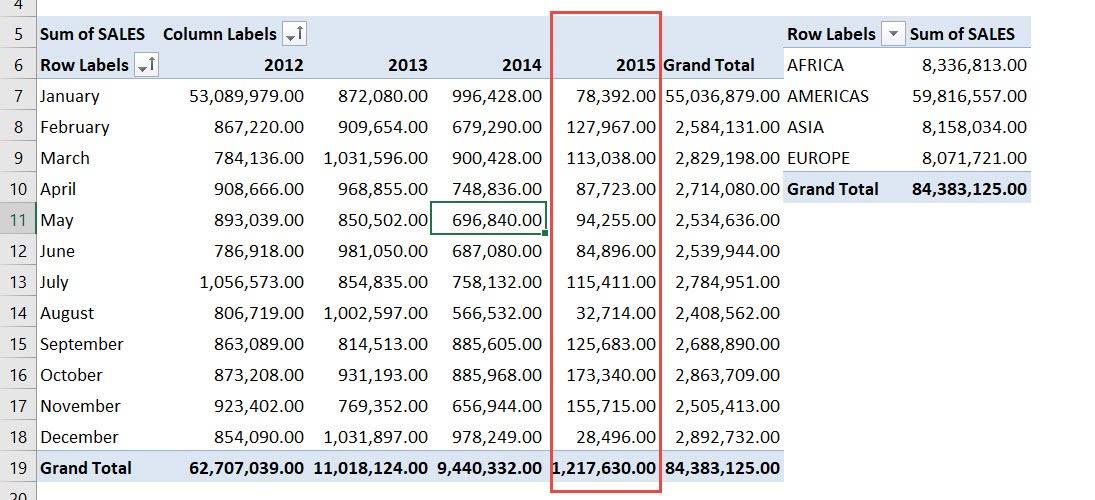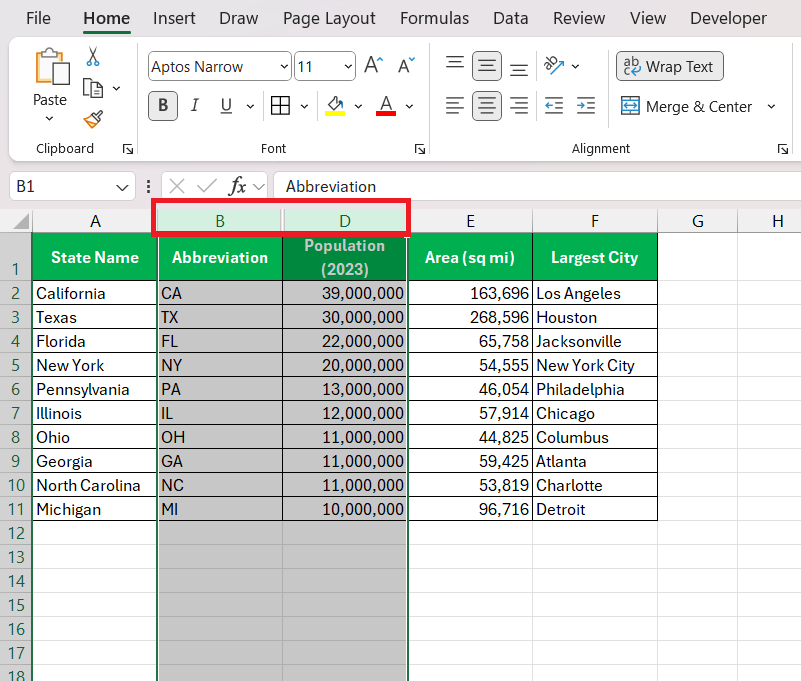Ever had the scenario wherein you updated your Pivot Table data source, then tried refreshing your Pivot Table, and this error shows up: “A PivotTable report cannot overlap another PivotTable report.” How do we find a solution for a PivotTable report that overlaps another PivotTable report? This means that one of your Pivot Tables is trying to expanded horizontally/vertically and will overlap with another Pivot Table.
Key Takeaways
- If you encounter the error message “A PivotTable report cannot overlap another PivotTable report,” it indicates that there is not enough space on the worksheet for one of the pivot tables to expand after adding new data to the pivot table data source. To resolve this, you can move one of the pivot tables to a different location where there’s sufficient space to accommodate the growth.
- To move a pivot table and prevent overlapping, you can use the “Move PivotTable” option located in the Analyze tab in the Excel ribbon. This allows you to relocate your pivot table to a new worksheet or to a specified area within the existing worksheet, ensuring that pivot tables do not overlap and can expand as needed.
- Resolving pivot table overlap by moving pivot tables to a new worksheet not only avoids the current overlapping issue but also anticipates future data source updates. This ensures that as data grows, the pivot tables have ample room to accommodate new entries and maintain proper functionality without errors.
You can simply select Move PivotTable and you can move your Excel Pivot Table very quickly to make more space!
For our example, we have added 2015 data to our data source, which will cause the first Pivot Table to overlap with the second Pivot Table.
Table of Contents
Steps To Fix Overlapping Pivot Tables in Excel
STEP 1: Let us see the error in action. Right click on any cell in the first Pivot Table. Click Refresh
Excel prohibits us from doing so.
STEP 2: Make sure you have selected your second Pivot Table. Go to PivotTable Tools > Analyze > Actions > Move PivotTable
STEP 3: Select the new location where you want to move it. You have the options to move the Pivot Table to a New Worksheet or Existing Worksheet.
In our example, we selected cell G5 and click OK.
STEP 4: Right click on any cell in the first Pivot Table. Click Refresh again so we can show the 2015 data in our Pivot Table report:
Voila! You are able to fix the overlapping Pivot Tables!
Prevention is Better Than Cure: Avoiding Future Overlaps
Best Practices for PivotTable Management
Creating a successful Excel workspace involves not just dealing with present issues but also taking steps to prevent future problems. When it comes to PivotTables, a proactive approach can save you from the headache of resolving errors such as overlaps.
Employing best practices in PivotTable management is key. One fundamental tip is to dedicate a single sheet to each PivotTable you create. When that’s not possible, ensure you leave ample space between tables. You can select around 10 columns right next to the first PivotTable and narrow them down to about 2.00 (19 pixels) width to act as a buffer zone. This way, when you refresh your PivotTables, they won’t expand into each other’s territory, preventing overlaps.
Be vigilant and regularly check for hidden columns as well; an unnoticed expansion into these could lead to data confusion. Reduce the risk by keeping columns narrow, which allows for immediate visibility if anything goes awry. Remember, spotting an overlap early on makes for an easier fix!
Tips for Organized Data Layout
For an efficiently functioning Excel workbook with multiple PivotTables, a well-organized data layout is non-negotiable. Here’s how you can keep things tidy:
- Always start with a plan for your workbook’s structure. Think about how many PivotTables you’ll need and strategize their locations on the sheets.
- Consider using a template for repetitive data layout structures. This ensures consistency across your workbook, making it easier to navigate and maintain.
- Implement a naming convention for your PivotTables and sheets. This allows you to identify data quickly and reduces confusion when looking for specific information.
- Utilize Excel’s grouping features to collapse and expand sections of your PivotTables. It helps in creating a clean layout while still keeping detailed data accessible.
- Reserve a ‘dashboard’ sheet that sums up all the key information from your various PivotTables. This can serve as a quick reference point without trawling through the more detailed tabs.
Incorporating these tips will not only enhance your data visualization but also make it easier to spot and avoid potential overlap issues among PivotTables, leading to a more efficient data management experience.
Expert Insights on Handling Complex PivotTable Overlaps
Handling Multiple PivotTables in Single Worksheet
When working with multiple PivotTables on a single worksheet, careful handling is crucial to maintain clarity and function. Here’s how you can manage this setup effectively:
- Space them out: Ensure each PivotTable has enough room to expand without encroaching on others. Use spacer columns, as previously mentioned, to create visual and practical buffers.
- Sync the source data: If possible, use the same range or data connection for all the PivotTables. This consistency helps prevent data mismatch and related overlaps.
- Separate source data: When using different sources, clearly delineate each data set to avoid mixing, which could cause one PivotTable to incorrectly absorb data meant for another.
It’s also wise to keep your PivotTables aligned, either horizontally or vertically, to create a clean, organized look that’s easier for you to monitor and for others to understand. Remember, with visibility comes control, allowing you to catch potential issues before they turn into actual overlap errors.
Advanced Solutions for Excel Professionals
For the seasoned Excel professionals tackling complex PivotTable overlaps, diving into more advanced solutions proves beneficial. Here are some sophisticated techniques:
- Use the PivotTable Options to set the ‘Number of items to retain per field’ to ‘None’. This minimizes memory usage and reduces the chance of unexpected data in your drop-down menus which can cause overlaps.
- Consider writing a macro that automatically adjusts the space between PivotTables upon refresh. A Visual Basic for Applications (VBA) script can dynamically check the last-used row of a PivotTable and adjust the location of adjacent PivotTables accordingly.
- Explore the use of Power Pivot, an advanced data modeling add-in for Excel. Power Pivot allows for the creation of sophisticated data models that can be manipulated without affecting the layout of regular PivotTables on the worksheet.
It’s a good practice to document any advanced customizations you make. This ensures that those who inherit your workbook will understand the logic behind the layout and maintain it properly.
FAQs: Quick Answers to Common PivotTable Overlapping Queries
What causes a PivotTable to overlap another PivotTable?
A PivotTable may overlap another when one or more of these occur: There’s an expansion in data, causing one PivotTable to grow into the space of the adjacent one; Two PivotTables are positioned too closely without sufficient buffer space; Or hidden rows/columns that unexpectedly unfold during a refresh. Adjustments in data sources or changes in layout that aren’t pre-planned can also trigger this issue.
Can I automatically prevent PivotTables from overlapping?
While there is no built-in feature to auto-prevent overlaps, you can manually disable the ‘Autofit column widths on update’ option in PivotTable settings. This stops columns from resizing when the PivotTable is refreshed, thus helping to maintain the layout without unexpected changes that could lead to overlapping.
How to fix a pivot table cannot overlap another pivot table report?
To fix an overlap, you can move the PivotTable that’s causing the issue: Click any cell within the PivotTable, head to the ‘Analyze’ tab in the Excel ribbon, select ‘Move PivotTable’, and then choose a new location, like a new worksheet or a section of the existing one with ample space. Confirm your selection, and Excel will automatically adjust the PivotTable’s position.

Bryan
Bryan Hong is an IT Software Developer for more than 10 years and has the following certifications: Microsoft Certified Professional Developer (MCPD): Web Developer, Microsoft Certified Technology Specialist (MCTS): Windows Applications, Microsoft Certified Systems Engineer (MCSE) and Microsoft Certified Systems Administrator (MCSA).
He is also an Amazon #1 bestselling author of 4 Microsoft Excel books and a teacher of Microsoft Excel & Office at the MyExecelOnline Academy Online Course.

